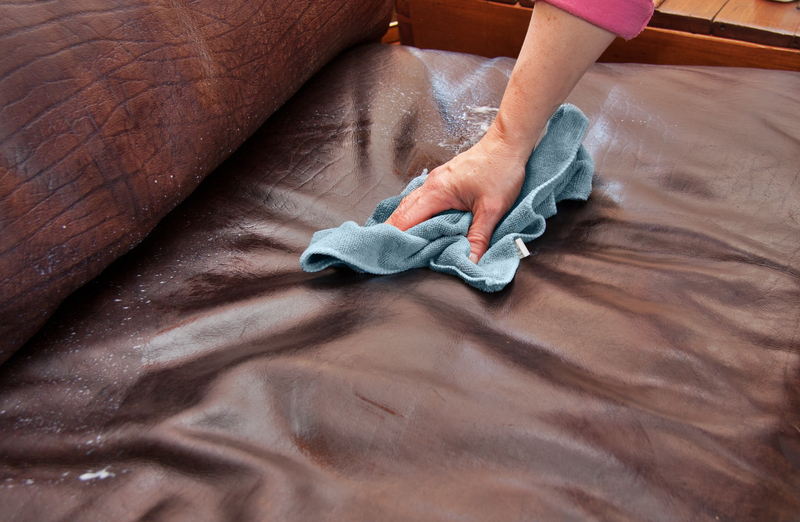Grease-Free Haven: Unveil the Secrets to Cleaning Enamel Oven Trays
Posted on 22/05/2025
Grease-Free Haven: Unveil the Secrets to Cleaning Enamel Oven Trays
In every modern kitchen, the trusty enamel oven tray is an unsung hero--absorbing spills, holding up casseroles, baking tasty treats, and often bearing the brunt of high-temperature cooking. Over time, these hard-working trays can accumulate stubborn grease and burnt-on residues, leaving many home cooks wondering: How can I efficiently clean enamel oven trays and keep them gleaming like new? Welcome to your comprehensive guide on creating a grease-free haven in your oven with expert tips and secrets for cleaning enamel oven trays.

Why Keep Enamel Oven Trays Spotless?
Hygiene and food quality are the cornerstones of any great kitchen. Regular cleaning prolongs the life of your oven trays, prevents cross-contamination, and enhances the flavor of your dishes. Grease buildup can harbor bacteria, impart unpleasant flavors, and even generate smoke during baking. Let's explore why cleaning enamel oven trays is non-negotiable:
- Improved Cooking Results: Clean trays ensure even heat distribution, so your meals cook to perfection every time.
- Prevention of Smoke and Odor: Old grease burns with every use, contaminating your food and home with persistent smells.
- Kitchen Aesthetic: A sparkling, grease-free oven tray complements your kitchen's visual appeal and inspires culinary creativity.
- Durability: Well-maintained enamel trays resist rust, chipping, and deterioration.
Understanding Your Enamel Oven Tray
Before diving in with scrubbers and detergents, it is essential to understand the nature of enamel oven trays. Enamel is a glass-like coating fused onto metal (typically steel or iron) that provides a smooth, non-reactive, and elegant cooking surface.
- Non-Porous Surface: Prevents absorption of grease and odors, making cleaning easier--provided stains are addressed promptly.
- Heat Resistant: Built to handle high oven temperatures without warping or discoloring.
- Scratch Vulnerability: Although robust, harsh abrasives may scratch enamel, so choosing the right cleaning tools is crucial.
Preparing for Enamel Oven Tray Cleaning
Proper preparation ensures effective and effortless cleaning. Assemble these simple, household ingredients and tools before you start:
- Baking Soda: A gentle, natural abrasive that lifts grime without scratching enamel.
- White Vinegar: Breaks down grease and enhances the effectiveness of baking soda.
- Dish Soap: Cuts through fresh, light grease and leaves trays smelling fresh.
- Soft Sponge/Non-Scratch Pad: Avoid steel wool or harsh scouring pads.
- Old Toothbrush: Perfect for corners and stubborn spots.
- Plastic Scraper: Helps remove stuck-on bits safely.
Step-by-Step Guide: How to Clean Enamel Oven Trays
Step 1: Let the Tray Cool Completely
Never attempt to clean a hot tray. Allow your enamel oven tray to come to room temperature before handling to prevent potential burns or thermal shock to the enamel coating.
Step 2: Remove Loose Debris
- Gently shake or tap the tray over a garbage bin to dislodge crumbs and food residues.
- Wipe with a paper towel if necessary.
Step 3: Soak with Warm Soapy Water
- Fill your sink with hot water and add a squirt of dishwashing liquid.
- Submerge the tray and leave for at least 20-30 minutes. For heavy soiling, allow a longer soak.
- This step softens burnt-on grease, making it easier to remove in the following steps.
Step 4: Scrub with Baking Soda Paste
- Combine baking soda with enough water to make a thick paste.
- Spread generously over stubborn grease patches and burnt areas.
- Let the paste sit on the affected areas for 15-20 minutes. Baking soda breaks down grease without damaging enamel.
- Gently scrub with a soft sponge or non-abrasive pad.
Step 5: Tackle Persistent Stains with Vinegar
- Spray or pour white vinegar over the baking soda paste. The fizzing reaction helps to lift persistent grime.
- Let it bubble for a few minutes before scrubbing again with your non-scratch sponge.
Step 6: Use a Plastic Scraper or Toothbrush
- For corners or stubborn spots, use a plastic scraper or an old toothbrush.
- Avoid metal tools that may scratch or damage the enamel coating.
Step 7: Rinse and Dry Thoroughly
- Rinse the tray in warm water, ensuring all residue is gone.
- Dry with a clean towel or air dry on a rack. Moisture can lead to rust on exposed metal edges.
Alternative and Natural Solutions for Cleaning Enamel Oven Trays
If you prefer to avoid commercial chemicals, here are eco-friendly methods to achieve grease-free enamel trays:
- Lemon Juice: The natural acidity cuts through grease. Sprinkle salt over stains, squeeze lemon juice, let it fizz, then scrub with a sponge.
- Baking Soda & Hydrogen Peroxide: Make a paste, apply to tough spots, and leave for thirty minutes before wiping away.
- Salt and Vinegar: Ideal for stubborn corners--sprinkle salt, add vinegar, and allow the mixture to work its magic before scrubbing.
Quick Cleaning for Lightly Soiled Enamel Trays
- Immediate Wash: After each use, rinse with hot water and mild dish soap before any grease hardens.
- Wipe with Vinegar: For a streak-free finish, wipe the tray with a cloth dampened with white vinegar.
- Dry Quickly: Always dry the tray promptly to prevent water spots and prolong its gleaming finish.
Preventing Grease Buildup: Maintain Your Grease-Free Enamel Oven Trays
The secret to effortless cleaning often lies in prevention. Practice these simple habits to keep your oven trays grease-free and fresh for longer:
- Use Parchment Paper or Tinfoil: Line trays with baking paper or foil when roasting to catch drips and reduce contact with grease.
- Wipe Immediately: Address minor spills and splatters quickly with a damp cloth to prevent baked-on stains.
- Regular Light Cleaning: Even if the tray looks clean, a quick wash after each use minimizes future buildup and ensures easy deep cleaning sessions.
- Don't Overload: Avoid overcrowding the tray, which can cause overflowing grease and stubborn stains.
Expert Tips to Restore the Shine to Your Enamel Oven Tray
- Don't Use Dishwasher for Frequent Cleaning: While many enamel trays are technically dishwasher-safe, repeated exposure to harsh detergents can dull the finish over time.
- Avoid Abrasive Cleaners: Steer clear of steel wool, wire brushes, or gritty powders. These can scratch the enamel, causing it to become sticky and harder to clean next time.
- Apply a Thin Layer of Cooking Oil: After cleaning and drying, wipe a tiny amount of neutral oil onto the tray to help prevent future sticking and fading.
- Deep Clean Monthly: Even if you regularly wipe your trays, a monthly deep clean keeps them looking immaculate and ready for any recipe.
Common Mistakes to Avoid When Cleaning Enamel Oven Trays
- Never use harsh abrasives: Steel wool or metal scourers can irreversibly scratch your tray.
- Don't soak forever: While soaking loosens grime, don't leave enamel trays submerged for hours--exposed metal can rust or discolor.
- Say no to oven cleaner sprays: Many contain strong chemicals that can damage the enamel surface.
- Avoid thermal shock: Plunging a hot tray into cold water can cause enamel to crack.
How to Remove Burnt-On Stains from Enamel Oven Trays
Burnt food and stubborn stains can make even the best-maintained trays appear unsightly. Here's a fail-safe method for deep cleaning:
- Sprinkle a generous layer of baking soda over the stain.
- Pour white vinegar on top and let the mixture bubble for 10 minutes.
- Scrub with a non-scratch sponge, focusing on the burnt area.
- For extra tough stains, apply a thick baking soda paste and leave overnight.
- Rinse thoroughly in the morning and repeat if necessary.
When to Replace Your Enamel Oven Tray
Even the most durable enamel trays have a lifespan. If you notice extensive chipping, rust patches, or deep scratches where the bare metal is exposed, consider replacing the tray. Damaged trays can leach iron into your food and lose their nonstick properties.

Frequently Asked Questions About Cleaning Enamel Oven Trays
Can I Use a Dishwasher to Clean Enamel Oven Trays?
It's usually safe for occasional cleaning, but hand washing is recommended to preserve the tray's glossy finish and prevent dishwasher detergent from dulling the surface.
Are Commercial Oven Cleaners Safe for Enamel Oven Trays?
Generally, avoid harsh oven sprays. These products often contain caustic chemicals that can damage enamel. Stick to gentle, household alternatives whenever possible.
What's the Best Way to Prevent Sticking?
Always lightly oil your tray, or use parchment paper when baking foods known to stick, like cookies, pastries, or oven fries.
The Journey to Grease-Free Enamel Oven Trays: Summary and Final Thoughts
Achieving and maintaining a spotless, grease-free enamel oven tray is not only about cleaning burnt-on food and grease--it's about developing a few smart, everyday habits in your kitchen routine. With the secrets and expert tips for cleaning enamel oven trays unveiled above, you can easily transform your oven into a grease-free haven. Say goodbye to stubborn stains and burnt-on grime, and hello to delicious meals cooked on trays that gleam like new.
- Clean thoroughly after each use to minimize buildup.
- Utilize the power of baking soda, vinegar, and gentle scrubbing tools for deep cleans.
- Embrace preventative habits like lining trays and drying completely after each wash.
- Avoid damaging practices that can compromise your tray's finish and longevity.
With these practical strategies, your enamel oven trays will stay immaculate, safe, and always ready for your next baking adventure. Enjoy your grease-free haven!
```


